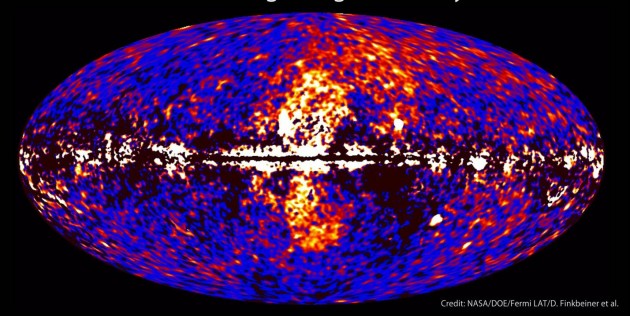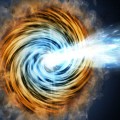NASA’s Fermi Gamma-ray Space Telescope has unveiled a previously unseen structure centered in the Milky Way–a finding likened in terms of scale to the discovery of a new continent on Earth. The feature, which spans 50,000 light-years, may be the remnant of an eruption from a supersized black hole at the center of our galaxy.
“What we see are two gamma-ray-emitting bubbles that extend 25,000 light-years north and south of the galactic center,” said Doug Finkbeiner, an astronomer at the Harvard-Smithsonian Center for Astrophysics in Cambridge, Mass., who first recognized the feature. “We don’t fully understand their nature or origin.”

From end to end, the newly discovered gamma-ray bubbles extend 50,000 light-years, or roughly half of the Milky Way’s diameter, as shown in this illustration. (Credit: NASA/GSFC)
The structure spans more than half of the sky, from the constellation Virgo to the constellation Grus. It may be millions of years old.
A paper on the findings will appear in an upcoming issue of The Astrophysical Journal.
Finkbeiner and Harvard graduate students Meng Su and Tracy Slatyer revealed the bubbles by processing publicly available data from the satellite’s Large Area Telescope. Their work expanded on previous studies led by Greg Dobler at the Kavli Institute for Theoretical Physics in Santa Barbara, Calif.
Fermi’s Large Area Telescope is the most sensitive and highest-resolution gamma-ray detector ever orbited. Gamma rays are the highest-energy form of light.

A giant gamma-ray structure was discovered by processing Fermi all-sky data at energies from 1 to 10 billion electron volts, shown here. The dumbbell-shaped feature (center) emerges from the galactic center and extends 50 degrees north and south from the plane of the Milky Way. (Credit: NASA/DOE/Fermi LAT/D. Finkbeiner et al.)
The structures eluded previous astronomers studying gamma rays due in part to the so-called diffuse emission–a fog of gamma rays that appears all over the sky. The emissions are caused by particles moving near the speed of light interacting with light and interstellar gas in the Milky Way.
Researchers believe that an important process for producing the Milky Way’s gamma-ray fog, called inverse Compton scattering, also lights up the bubbles. In that process, electrons moving near the speed of light collide with low-energy light, such as radio or infrared photons. The collision increases the energy of the photons into the gamma-ray part of the electromagnetic spectrum.
The bubble emissions are much more energetic than the gamma-ray fog seen elsewhere in the Milky Way.
The bubbles also appear to have well-defined edges. Taken together, the structure’s shape and emissions suggest that it was formed as a result of a large and relatively rapid energy release — the source of which remains a mystery, Finkbeiner noted.





